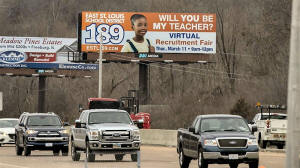EDUCATOR SHORTAGES IN ILLINOIS: Teacher shortage worsening for most
Illinois districts, survey shows
 Send a link to a friend
Send a link to a friend
[March 01, 2021]
By PETER HANCOCK
Capitol News Illinois
phancock@capitolnewsillinois.com
 SPRINGFIELD – A new survey of Illinois
school districts shows most are continuing to have trouble filling open
teaching positions with qualified teachers and even more are having
difficulty hiring substitute teachers. SPRINGFIELD – A new survey of Illinois
school districts shows most are continuing to have trouble filling open
teaching positions with qualified teachers and even more are having
difficulty hiring substitute teachers.
It’s a problem that has existed in the state for many years and one that
experts attribute to a variety of factors, such as low pay and the
difficulty in attracting new teachers to work in certain parts of the
state.
The survey has been conducted each of the past four years by the
Illinois Association of Regional Superintendents of Schools. Regional
superintendents are in charge of supervising schools in the state’s 38
educational regions and operating regional offices of education. They
also act as a kind of conduit of information and support between the
Illinois State Board of Education and the state’s 853 local school
districts.

“You know, it's not like we just stubbed our toe, this is a crisis,”
IARSS President Mark Klaisner said in an interview. “It's getting worse
each year. And when we asked them to look forward, they said, you know,
in the next five years, we don't see this changing.”
The latest survey was conducted in early October and included responses
from 591 of the state’s 853 districts. Of those responding, 77 percent
said they have a teacher shortage problem while 93 percent said they
have a problem hiring substitute teachers, particularly since the start
of the COVID-19 pandemic.
Individual districts have responded to the shortage in a variety of
ways, such as canceling the offering of some classes or switching them
to online formats as well as filling critical positions with teachers
who are not fully qualified to teach in a particular grade level or
subject area.
In fact, the districts that responded to the survey reported a combined
total of 938 open teaching positions – 17 percent of the 5,414 positions
that districts were looking to fill – were either unfilled or filled by
someone who was not certified in that grade level or subject area. That
percentage, however, is actually down from previous surveys. In 2017,
districts reported that 28 percent of their open positions were either
vacant or filled by someone not fully qualified.
The largest number of those was in special education at all grade
levels, where 195 positions were either vacant or filled by an
unqualified teacher. In terms of percentages, though, computer science
teachers were also hard to come by. Forty-one percent of the open
computer science positions were either vacant or filled by an
unqualified teacher.
Districts also reported having trouble filling elementary education,
math, physical education and science positions.
The survey also found that 257 classes offered in the participating
districts had been canceled and 195 had been moved online because school
administrators could not find educators to teach them.
The severity of shortages also varied by region. In west central
Illinois, for example, 89 percent of the districts responding to the
survey reported having a teacher shortage problem, compared to only 55
percent of the districts in northeast Illinois.
Causes of the shortage
Education researchers in Illinois say the reasons for the teacher
shortage are numerous and complex, but it boils down to the fact that
there are more veteran teachers around the state retiring or leaving the
profession than there are new teachers coming out of university schools
of education.
James Anderson, dean of the University of Illinois Urbana-Champaign’s
College of Education, said in an interview that for a variety of
reasons, including the cost of a college education and the salaries
teachers earn after graduating, teaching has become a less attractive
career than many other professions.

“You graduate from high school, you come to college to become a teacher,
you borrow a significant amount of money along the way, then you go into
the profession with a very low salary,” he said. “And then you try to
pay off your student debt and perform your job as a teacher. And that's
a very difficult invitation to accept.”
The minimum wage for a teacher in Illinois is $34,576 for the 2021-2022
school year and is scheduled to increase under state law to $40,000 by
the 2023-2024 school year.
An analysis of the survey results showed a strong correlation between
the severity of the shortage and the average teacher salary in a given
district. As teacher salaries increase, superintendents report less of a
problem with teacher shortages.
The survey also found correlations between teacher shortages and a
district’s wealth. Districts with larger percentages of low-income
students tended to have worse shortages while districts with large
numbers of teachers holding master’s degrees had less of a shortage.
Local superintendents also reported having difficulty recruiting
teachers to work in certain parts of the state, especially remote rural
areas. Eighty-seven percent of rural districts participating in the
survey reported having a teacher shortage, compared to 76 percent of
suburban districts and 62 percent of urban districts.
[to top of second column]
|

A billboard located along Illinois State route 15 in
Centreville, Illlinois advertises for teachers for East St. Louis
School District 189. (Credit: Belleville News-Democrat)

COVID-19 impact
As schools throughout the state were forced to shift to online
learning amid the COVID-19 pandemic, two-thirds of the districts
responding to the survey said it has reduced their need for
substitute teachers. Meanwhile, most districts responding to the
survey, 51 percent, said the pandemic has not resulted in higher
turnover rates while nearly as many, 49 percent, said it does not
appear to have had an impact on teacher burnout.
Some districts, however, said the pandemic has made finding
substitutes more difficult amid a return to the classroom.
“COVID-19 has had the greatest impact on our substitute teacher
shortage,” Steven Wrobleski, superintendent of La Salle-Peru
Township High School in northwest Illinois, said in an interview.
“Since our sub pool tends to be an older crowd, COVID-19 has kept
many subs out of the schools for fear of catching the virus.”
Thirty-seven percent of the districts surveyed reported they had
hired additional teachers to meet the demands of COVID-19, while 40
percent said they had hired additional paraprofessionals.
In addition, early in the pandemic, Gov. JB Pritzker issued an
executive order waiving certain licensing requirements for teachers,
making it easier for new teachers and paraprofessionals to enter the
profession, although some of those waivers have since expired.
However, two independent education consultants who wrote an analysis
of the survey data, Bradford White and Thomas Withee, said the
pandemic could have an impact on the supply of teachers in future
years because it has depressed enrollment in higher education,
exacerbating the downward trend in the number of students graduating
from teacher preparation programs.
They also said it is still unclear how the pandemic might affect
attrition rates going forward.
“The difficulty that districts are having with finding teachers to
replace those that leave has escalated the need to improve the
teacher retention rate,” White and Withee wrote. “High attrition
rates among school leaders pose a greater need for an expanded
leadership pipeline of candidates.”

But Jim Wolfinger, dean of Illinois State University’s College of
Education, the state’s largest teacher preparation program, said in
an interview that he is more hopeful that as the pandemic eases,
interest in the teaching profession will rebound.
He said there is stability in teaching as the effects of the
pandemic on other sectors of the economy remain to be seen.
“And to invest in a college degree, when you're not sure if you're
going to be in a workplace, or if everything's going to be virtual,
and what's it going to look like to go into, say, hospitality
management, or into journalism, for that matter? What do those
careers look like?” he said. “Whereas education is a pretty stable
line of work. When you look at the salaries, people don't get rich,
but it is a stable employer.”
Recommendations
In the report, the regional superintendents offer a number of
recommendations to ease the teacher shortage, such as continuing to
extend some of the waivers Pritzker initiated to make it easier for
new teachers to become licensed. One of those is the requirement
that prospective teachers pass a test called the Teacher Performance
Assessment, or edTPA, which Illinois lawmakers have considered in
recent years but have not yet acted upon.
“Great work has been done to make the entry licensure requirements
less strict. However, we must take a serious look at the
effectiveness (and negative impact) of the edTPA,” one unnamed local
superintendent was quoted as saying in the survey.
Another recommendation is to expand on a program Illinois State
University has launched to offer teacher training courses through
satellite campuses throughout the state. That is an effort to
attract more nontraditional candidates who might be considering a
career change but are not otherwise in a position to pack up and
move to university towns like Bloomington-Normal or
Champaign-Urbana.
The regional superintendents also recommend Illinois lawmakers
consider establishing a state-sponsored loan forgiveness program for
teachers that go to work in schools and districts with the greatest
shortages or in hard-to-fill subject areas.
ISU’s Wolfinger and U of I’s Anderson both agreed with that
recommendation as well.
“We need federal support for scholarships for teachers as well,”
Anderson said. “But we have to decrease the cost of preparation.
Otherwise, it's not going to be attractive to high school graduates.
And that's the one thing that we can control in terms of government
and colleges of education."
Capitol News Illinois is a nonprofit, nonpartisan
news service covering state government and distributed to more than
400 newspapers statewide. It is funded primarily by the Illinois
Press Foundation and the Robert R. McCormick Foundation. |